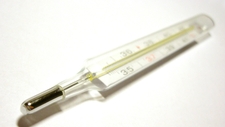Measuring Temperature

TEKS Objective
The student is expected to collect, record, and analyze information using tools, including microscopes, cameras, computers, hand lenses, metric rulers, Celsius thermometers, wind vanes, rain gauges, pan balances, graduated cylinders, beakers, spring scales, hot plates, meter sticks, compasses, magnets, collecting nets, notebooks, sound recorders, and Sun, Earth, and Moon system models; timing devices, including clocks and stopwatches; and materials to support observation of habitats of organisms such as terrariums and aquariums.
Essential Understanding
The student knows how to use a variety of tools and methods to conduct science inquiry.
Science Background
Thermal Energy Physics: Thermalenergy.org (website) - Explains the physical science of thermal energy and relates it to heat, absolute zero, temperature scale and more.
Signature Lesson
How Much Heat Will It Hold? TeachEngineering (website) - Students relate thermal energy to heat capacity by collecting, recording and analyzing information to compare the heat capacities of different materials. Students graph the change in temperature over time for a specific material and learn why heat capacity is an important property of thermal energy.
How Much Heat Will It Hold?
TeachEngineering, www.teachengineering.org
- Supporting Lessons
- Extensions
- Assessment Ideas
- Literature Connections
- Related
TEKS - Additional Resources
Supporting Lessons
Temperature: Teacher Vision (PDF) - Download the printable sheet to guide students through an activity in which they compare different situations, such as freezing and boiling.
Elaboration Lessons and Extensions
Physics in a Bottle, Expanding Thermometers: Physics Center (website) - Students build their own thermometers with a water bottle and a straw, then test the thermometer by placing it in cold and warm water.
Physics in a Bottle, Expanding Thermometers
Physics Central, www.physicscentral.com
Assessment Ideas
Interactive Thermometer: Mathisfun.com (website) - Have students rank different items identified by the interactive thermometer, from coldest to hottest.
Literature Connections
Temperature: Heating Up and Cooling Down. Stille, D. (ISBN-13: 978-1404803459)
Additional Resources
Temperature Game: NASA (website) - Students learn about the relative temperature of different locations and objects.
TEKS Navigation
Grade 3
Need Assistance?
If you need help or have a question please use the links below to help resolve your problem.

Comments